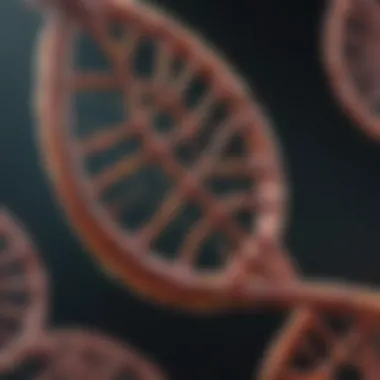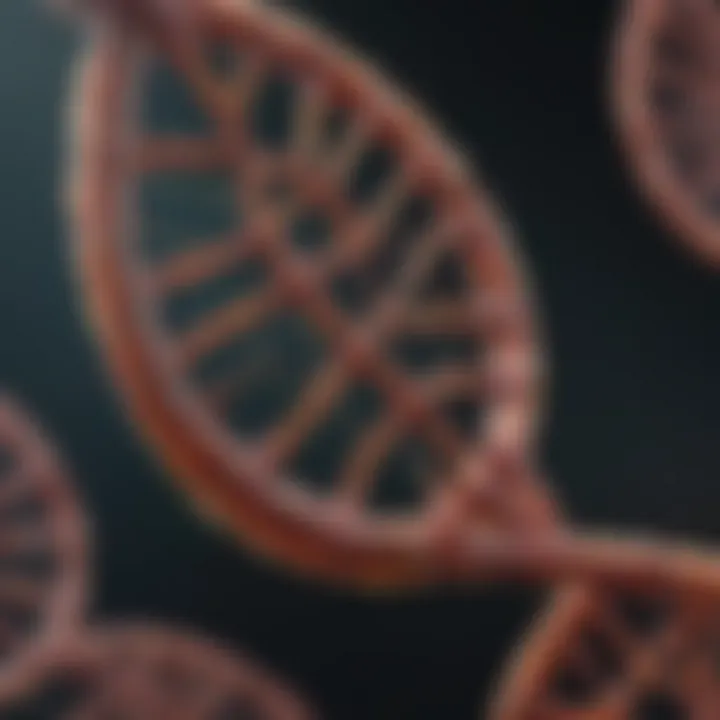MTDNA Analysis: Unraveling Genetic Insights in Science


Intro
Mitochondrial DNA (mtDNA) analysis serves as a critical lens through which we can examine various aspects of genetics. This analysis is not just a tool for understanding ancestry, but it also has broader implications for various fields such as medicine, forensic science, and evolutionary biology. Only by comprehending the intricate features of mtDNA can one appreciate its significance in contemporary scientific research.
The focus on mtDNA stems from its unique characteristics. Unlike nuclear DNA, mtDNA is inherited solely from the mother and is present in multiple copies within each cell. This property allows for more abundant genetic material to analyze, which is invaluable in research settings. By diving into mtDNA analysis, we can uncover insights about transmission of genetic disorders, population dynamics, and human evolution.
The relevance of this topic transcends academic boundaries and impacts real-world applications. Researchers engage with ethical considerations and the complexities of data interpretation, inviting a nuanced discussion around how we approach genetic information. Thus, focusing on this field has never been more critical.
Research Overview
Key Findings
Recent studies in mtDNA analysis have revealed important patterns regarding human migration, genetic diversity, and disease linkage. This analysis helps identify varied contributions of maternal lineage, offering deeper insights into specific populations. For example, certain haplogroups have been connected to distinct health outcomes, providing potential pathways for medical research related to mitochondrial disorders.
Moreover, forensic applications of mtDNA have shown promising utility in criminal investigations and identification of missing persons. Its specificity and the number of copies available make it particularly useful in scenarios where nuclear DNA is compromised or degraded.
Study Methodology
The methodologies employed in mtDNA analysis are varied but generally follow several key methodologies:
- Sample Preparation: Biological samples, such as blood, saliva, or hair, are collected to extract mtDNA.
- Amplification: Polymerase Chain Reaction (PCR) is often used to amplify mtDNA, creating a substantial quantity for analysis.
- Sequencing and Analysis: Following amplification, sequencing techniques such as Sanger sequencing or next-generation sequencing allow researchers to read the genetic code.
The data obtained is then subjected to bioinformatic analysis to identify mutations, haplogroups, and ancestry-related information.
Background and Context
Historical Background
Mitochondrial DNA was first identified in the 1960s. Over the decades, its unique properties made it a subject of great interest. It is pivotal in understanding human evolution and the significant migratory events that have shaped modern populations. Researchers began using mtDNA as a way to trace lineage back to common ancestors, leading to the development of mitochondrial Eve theory.
Current Trends in the Field
In recent years, mtDNA analysis has progressed with technological advancements. The integration of high-throughput sequencing technologies has enabled more comprehensive studies of mtDNA variation and its role in both health and disease.
The emergence of big data analytics in genetics has also transformed how researchers interpret mtDNA sequences. Enhanced computational tools allow for more sophisticated assessments of genetic information.
"The future of mtDNA research is poised to reveal even more about our genetic heritage and the roles these tiny genomes play in health and disease."
By engaging with both the methodologies and the context surrounding mtDNA analysis, this piece aims to elucidate the importance of this field in modern scientific inquiry.
Understanding Mitochondrial DNA
Mitochondrial DNA, or mtDNA, has garnered attention in genetic research for its unique characteristics and applications. Understanding this form of DNA is crucial as it provides insights into maternal lineage, evolutionary biology, and various genetic disorders. The significance of mtDNA lies not only in its role as a genetic marker but also in how it helps in tracing ancestry, studying population dynamics, and investigating mitochondrial diseases.
Definition and Structure of mtDNA
Mitochondrial DNA is a circular DNA molecule located in the mitochondria, the energy-producing organelles within cells. It is distinct from nuclear DNA, which is found within the cell's nucleus. Each mitochondrion contains multiple copies of mtDNA, and in humans, this genetic material comprises approximately 16,500 base pairs. Unlike nuclear DNA, mtDNA is inherited exclusively from the mother, making it a powerful tool for tracing maternal ancestry.
The structure of mtDNA includes various genes that are essential for mitochondrial function. These genes are primarily involved in the production of proteins related to energy metabolism. The compact nature of mtDNA allows for efficient coding and regulation of its functions. Furthermore, there are also non-coding regions within mtDNA that may play roles in gene expression and regulation. Understanding the definition and structure of mtDNA is fundamental for researchers who study genetics and its implications in evolutionary biology.
Differences Between Nuclear and Mitochondrial DNA
One of the key distinctions between mtDNA and nuclear DNA lies in their inheritance patterns. While nuclear DNA is inherited from both parents, mtDNA is transmitted only from the mother. This matrilineal inheritance provides a clearer picture of maternal lineage.
Additionally, the physical structure of mtDNA differs from that of nuclear DNA. Nuclear DNA is linear and organized into chromosomes, whereas mtDNA is circular. This structural difference contributes to how each type of DNA is replicated and repaired. Moreover, mtDNA mutates at a faster rate than nuclear DNA, which can offer insights into population genetics and evolutionary changes over time.
In terms of quantity, a single human cell contains two copies of nuclear DNA but can contain hundreds to thousands of copies of mtDNA. This higher abundance can make mtDNA easier to detect in certain analyses, such as forensic applications. Understanding these differences is essential for utilizing mtDNA effectively in various fields like genealogy, medicine, and evolutionary studies.
"Mitochondrial DNA serves as a powerful tool in drawing connections between individuals, populations, and evolutionary history."


By comprehending the fundamental aspects of mitochondrial DNA, researchers can harness its potential in many areas, including gene therapy and population genetics. The implications are significant, not only for scientific exploration but also for practical applications in medicine and ancestry research. This section sets the stage for deeper insights into the historical context and methodologies utilized in mtDNA analysis.
Historical Context of mtDNA Research
Understanding the historical context of mitochondrial DNA (mtDNA) research is crucial for grasping its significance in the fields of genetics and evolution. This section will analyze how early explorations laid the groundwork for current methodologies and applications, thus illuminating the trajectory of mitochondrial studies.
The importance of this context lies not only in understanding past discoveries but also in recognizing how they inform present and future research. Analyzing mtDNA has become a major avenue for uncovering insights related to ancestry, genetic disorders, and evolution. As research has progressed, it has continually expanded the horizon of genetic exploration and comprehension.
Origins of Mitochondrial DNA Study
Mitochondrial DNA was first characterized in the 1960s. This was a period when researchers began to realize that mtDNA was distinct from the nuclear DNA found in the cell nucleus. Mitochondria, often referred to as the powerhouses of the cell, provide energy necessary for cellular function. Studies showed that mtDNA is inherited maternally, paving the way for its use in tracing lineage and genetic heritage.
In the early days, scientists primarily focused on understanding the structure of mtDNA and its role in cellular respiration. The implications of these findings led to increased interest in how mtDNA could be utilized in genetic research.
Key Milestones in mtDNA Research
Over the years, numerous milestones have marked the evolution of mtDNA research. Understanding these milestones allows for a clearer picture of how the field has developed. Some significant moments include:
- Discovery of mtDNA: Initial sequencing and characterization provided the foundation for further genetic analysis.
- Haeckel's Theory: In the late 19th century, Ernst Haeckel proposed that mitochondria were once free-living organisms, a concept that later gained support through endosymbiotic theory.
- Advent of Sequencing Technologies: The refinement of sequencing technologies in the 1980s allowed for more precise analysis, enhancing the ability to study evolutionary relationships and migrations through mtDNA.
This powerful tool has transformed the approach to genetic research and has opened new avenues for investigating human history and biology.
- Complete mtDNA Sequence of Homo sapiens: The first complete mtDNA sequence of human was published in 1981, enabling researchers to trace maternal lineages and better understand human evolution.
- Forensic Applications: By the 1990s, mtDNA analysis found widespread use in forensic science for identifying remains and linking suspects to crimes.
These key milestones illustrate not only the advancement in technologies but also the expansion of mtDNA's relevance across various disciplines. Each development built upon the last, featuring interconnections that demonstrate the interdisciplinary nature of genetic research.
In summary, the historical context of mtDNA research plays an essential role in shaping our understanding of genetics today. Knowledge from the past enriches the ongoing discourse, driving innovations and implicating future research pathways.
Methodologies for mtDNA Analysis
Understanding methodologies for mitochondrial DNA (mtDNA) analysis is essential for anyone working in genetics. These methodologies form a framework that supports diverse applications, from genealogical research to forensic investigations and medical diagnostics. This area of study is continually evolving with advancements in technologies and approaches, enhancing our ability to interpret complex genetic information.
Sampling Techniques
Sampling techniques are critical for obtaining mitochondrial DNA that accurately reflects the genetic material of the individual or population under study. Quality of samples can greatly influence the outcomes of an mtDNA analysis.
Sample collection can be performed on various biological materials. Common sources include blood, saliva, hair follicles, and bone. Each source has its pros and cons:
- Blood is rich in nucleated cells and often used in clinical settings.
- Saliva is non-invasive and easy to collect, but may yield lower DNA quality.
- Hair follicles must contain the root to ensure DNA extraction success.
- Bone is valuable in archaeological contexts but requires careful handling.
Additionally, ensuring that samples are collected and stored under appropriate conditions is vital. Degradation of DNA can occur if samples are exposed to heat or moisture, affecting the reliability of the results.
Sequencing Technologies in mtDNA Analysis
Sequencing technologies for mtDNA analysis have progressed rapidly. Methods of sequencing directly affect the accuracy and the depth of information retrieved from mtDNA.
Historically, Sanger sequencing was the gold standard, offering good accuracy for specific regions of the mtDNA. However, the emergence of next-generation sequencing (NGS) has revolutionized the field. NGS provides:
- High-Throughput Capacity: Allows for simultaneous sequencing of multiple samples, saving time and resources.
- Cost-Effectiveness: As technologies advance, the cost of sequencing has decreased, making it more accessible for various research projects.
- Comprehensive Data: NGS can capture entire mitochondrial genomes in a single run, which enhances our understanding of individual variations and population genetics.
As sequencing technologies continue to develop, they improve both the depth of insights into mtDNA and how we can apply these insights across different fields.
Bioinformatics Tools for Data Processing
Data processing in mtDNA analysis relies heavily on bioinformatics. After sequencing, substantial volumes of data need to be analyzed, interpreted, and stored. Effective bioinformatics tools are essential for revealing meaningful patterns.
Key aspects of bioinformatics in mtDNA include:
- Data Alignment: Aligning sequences to reference genomes to identify variations.
- Variant Calling: Identifying nucleotide changes that may correlate with specific traits or diseases.
- Population Genomic Analysis: Tools that help in the studies of genetic diversity, historical demography, and ancestry.


Prominent bioinformatics software tools such as GATK (Genome Analysis Toolkit) and PLINK are frequently used. These tools provide researchers with reliable platforms for complex analyses, enabling deeper understanding of genetic relationships.
In summary, methodologies for mtDNA analysis underpin many advancements in genetics, impacting fields from evolutionary biology to forensic science. As these methodologies evolve, they promise to enhance our grasp of mtDNA and its implications for various scientific inquiries.
Applications of mtDNA Analysis
Mitochondrial DNA (mtDNA) analysis has become a vital instrument in multiple fields. It does not only offer insights into genetic lineage but also reveals important information regarding population dynamics and health conditions. The applications of mtDNA analysis are diverse and impactful, making it an essential focus in both scientific research and practical applications. Understanding these uses can highlight the importance of this analytical method and its potential to effect meaningful change in various domains.
Genealogical Research
One of the primary uses of mtDNA analysis is in genealogical research. Individuals seeking to trace their ancestry can obtain genetic data that illustrates maternal lineage. Unlike nuclear DNA, mtDNA is inherited only from the mother, which simplifies the tracing process. This allows individuals to establish connections to distant ancestors or unveil previously unknown familial ties. Furthermore, genetic similarities in mtDNA can provide insights into regional ancestry, revealing potential historical migrations.
- Benefits of Genealogical Research:
- Establishes maternal connections that are otherwise difficult to trace.
- Helps in understanding historical migration patterns and population origins.
- Can clarify the history of specific family lines, illuminating connections to famous ancestors or significant historical figures.
Forensic Science and Criminal Investigations
Forensic science extensively utilizes mtDNA analysis due to its ability to generate DNA profiles from smaller biological samples. This is crucial in criminal investigations where DNA from a crime scene may be degraded or limited. Mitochondrial DNA can provide a unique advantage in identifying remains or biological evidence, even in cases of mass disasters. By linking mtDNA profiles from evidence to known familial profiles, forensic scientists can confirm or exclude potential suspects ultimately aiding in solving cases.
"The potential of mtDNA in forensic science represents a significant advancement in identifying individuals with limited biological material available."
- Key Factors:
- It can analyze samples like hair, bones, and teeth, which might not hold sufficient nuclear DNA.
- Offers crucial support in cases involving unidentified victims.
- Enhances the reliability of genetic evidence in court situations, contributing to justice.
Medical Diagnostics of Mitochondrial Disorders
Mitochondrial disorders often arise from mutations within mtDNA affecting cellular energy production. Diagnosing these disorders can be complicated due to their variable expression. However, mtDNA analysis makes it possible for medical professionals to identify specific mutations and assess their implications. This enables clinicians to tailor treatments and offer informed counseling about the risks of inheritance. Early diagnosis can significantly improve management strategies in affected individuals.
- Clinical Implications:
- Provides a genetic basis for diagnosing mitochondrial diseases.
- Facilitates personalized treatment plans based on individual genetic profiles.
- Informs patients and families about risk factors associated with inheritance.
Population Genetics and Evolutionary Studies
The application of mtDNA analysis extends into the realm of population genetics and evolutionary studies. Researchers can study mtDNA variations across populations to understand evolutionary processes, migration, and adaptation. By analyzing genetic changes over generations, scientists can deduce how groups have evolved and adapted to different environments. This analysis not only illustrates the genetic diversity within human populations but also contributes to broader understanding of human evolution.
- Significance in Research:
- Provides clarity on ancient human migrations and adaptations.
- Assists in revealing patterns of genetic diversity and relationships in populations.
- aids in tracing lineage that can inform conservation efforts and public health initiatives.
Ethical Considerations in mtDNA Research
The ethical considerations surrounding mitochondrial DNA (mtDNA) research are paramount in guiding the responsible application of this powerful technology. As mtDNA analysis becomes increasingly prevalent in fields such as genealogical research, forensic science, and medical diagnostics, understanding the ethical landscape is critical. Among the key areas of concern are issues of consent, data privacy, and the implications of ancestry disclosure. Addressing these concerns not only protects individuals but also maintains the integrity of the scientific community.
Consent and Data Privacy
Consent is a foundational element in conducting ethical research. In the context of mtDNA analysis, obtaining informed consent is essential. Participants must be fully aware of how their genetic information will be used, the potential risks involved, and the implications of sharing their data. Researchers must provide clear explanations about the study and allow individuals the opportunity to ask questions.
Furthermore, data privacy is a significant issue. Genetic information is sensitive by nature; therefore, safeguarding this data should be a top priority. Researchers must implement robust security measures to prevent unauthorized access to genetic data. This includes anonymizing data, utilizing encryption, and limiting data sharing to only essential parties. Failure to address data privacy can lead to serious consequences, including discrimination in insurance or employment.
Ensuring informed consent and protecting data privacy are essential to maintaining trust between researchers and participants.
Implications of Ancestry Disclosure
Ancestry disclosure is another complex area of ethical concern in mtDNA research. When individuals receive results about their genetic lineage, they may uncover sensitive information regarding familial relationships or possible genetic disorders. This can lead to emotional and psychological impacts that researchers must consider.
Furthermore, the implications of ancestry information can extend beyond the individual. Unanticipated discoveries could affect family dynamics, including the revelation of paternity issues or uncovering previously unknown relatives. Researchers must inform participants about these possibilities and provide support resources to help them navigate such discoveries.


Lastly, the broader societal impact must be taken into account. As more people access genetic testing services, there’s a potential for genetic data to influence perceptions and beliefs about ancestry, identity, and health disparities. This necessitates careful consideration of how findings from mtDNA studies are presented to the public to avoid stigmatization or misinterpretation.
Challenges and Limitations
Mitochondrial DNA analysis offers immense opportunities in genetic research and applications. However, the journey embraces various challenges and limitations that affect its reliability and interpretability. Understanding these impediments is vital for researchers and applications alike. Knowledge of these challenges not only aids in refining methodologies but also serves as a guideline for future investigations, enhancing the overall body of mtDNA research.
Technical Challenges in mtDNA Analysis
Technical challenges in mtDNA analysis span across multiple domains, affecting sampling, sequencing, and data processing. At the outset, obtaining quality samples is paramount. Contamination during sample collection can compromise results. This is particularly a concern in forensic settings, where non-target mtDNA sequences may inadvertently influence findings.
Another technical challenge lies in sequencing. Mitochondrial DNA is generally circular and consists of less nucleotide variation compared to nuclear DNA. This leads to ambiguous results when analyzing closely related samples or populations with little genetic divergence. Additionally, the emerging sequencing technologies, while beneficial, often produce large data sets but can introduce complications in error rates and needs for thorough validation.
Finally, the analysis phase encounters hurdles such as inadequate bioinformatics tools to handle complex mtDNA datasets. Many conventional tools may not be optimized for mitochondrial data, causing misalignments that result in misleading interpretations.
Interpretation of mtDNA Data
Interpreting mtDNA data requires a nuanced approach, given that the implications are layered and complex. One significant aspect is understanding the concept of homoplasmy and heteroplasmy. Homoplasmy, the presence of only one type of mtDNA within a cell, simplifies data interpretation. Conversely, heteroplasmy, the coexistence of multiple mtDNA variants, complicates the landscape and can lead to misinterpretations in evolutionary and medical contexts.
Moreover, the context of the data is crucial. Variations in mtDNA can reflect maternal lineage and disease susceptibility. Analyzing these aspects requires expertise, as simple correlations may not provide accurate insights. Researchers must be cautious of over-interpretation as misreading data can lead to erroneous conclusions about ancestry or genetic disorders.
In summary, while mtDNA analysis is a powerful tool for various research areas, it is not devoid of difficulties. Addressing these challenges is essential for the advancement of mitochondrial research and its applications in medicine, forensics, and ancestry studies. Understanding the technical and interpretative limitations prepares researchers to approach their work with the precision and accuracy it demands.
Future Directions in mtDNA Research
Understanding the future of mitochondrial DNA (mtDNA) research is crucial for continuing advancements in genetics, medicine, and evolutionary studies. As our knowledge grows, new methodologies and technologies emerge, influencing how we analyze and interpret mtDNA data. The interdisciplinary approach taken in mtDNA analysis is increasingly valuable. This section explores two significant aspects: advancements in sequencing technologies and the integration of mtDNA with other genomic data.
Advancements in Sequencing Technologies
The field of sequencing technologies is evolving rapidly. High-throughput sequencing, also known as next-generation sequencing (NGS), has transformed mtDNA analysis. This technology enables the sequencing of entire mitochondrial genomes quickly and cost-effectively. Several leading technologies deserve mention in this context:
- Illumina Sequencing: This method allows researchers to produce vast amounts of data efficiently. It enables the detailed study of genetic variations within mtDNA, providing insights into population genetics.
- PacBio Sequencing: Known for its long-read capabilities, this technology aids in resolving complex regions of mtDNA that shorter reads might miss. It contributes to more accurate sequencing of heteroplasmic variants.
- Oxford Nanopore Technologies: This approach allows for real-time sequencing with portable devices. This could revolutionize field research, making it easier to conduct genetic analysis in remote areas.
The progress in sequencing technologies not only enhances the resolution of mtDNA studies but also opens doors to new research areas, such as personalized medicine and deeper evolutionary insights.
Integrating mtDNA with Other Genomic Data
The integration of mtDNA data with other genomic information represents a frontier rich with potential. By combining mtDNA analysis with nuclear genomic data, researchers can create a more comprehensive picture of genetic heritage.
This approach has several benefits:
- Holistic Genetic Models: Merging mtDNA with nuclear DNA provides insights into both maternal lineage and overall genetic inheritance, which is essential in studies of ancestry.
- Understanding Disease Mechanisms: By analyzing mtDNA alongside other genomic data, researchers can identify pathways in various diseases. This is particularly important in mitochondrial disorders, where complex interactions between mitochondrial and nuclear genomes may influence disease expression.
- Phylogenetic Studies: Combining datasets aids in constructing phylogenetic trees that illustrate evolutionary relationships better. This integration helps in understanding how mtDNA variations correlate with traits across species.
The synergy between mtDNA and other genomic data has the potential to enhance the depth of genetic research significantly.
"Advancements in sequencing technologies and data integration are pushing the boundaries of our understanding of genetics and ancestry, making it possible to answer questions that were inconceivable a decade ago."
In summary, the future of mtDNA research lies in harnessing new sequencing methodologies and integrating mtDNA data with a broader genomic context. This evolution will surely elevate the quality and depth of research in genetics, paving the way for new discoveries.
End
The conclusion of this article emphasizes the integral role mitochondrial DNA (mtDNA) analysis plays in the current landscape of genetics and related fields. As we have explored throughout the article, mtDNA analysis is not merely a technique; it is a window into understanding lineage and disease. Its contributions span genealogical research, forensic science, and medicine. Consequently, we see that the implications of mtDNA extend beyond individual cases into larger societal concerns regarding ancestry and genetic heritage.
Recap of Key Insights
Reflecting on the key insights of this article, several important points stand out:
- Understanding mtDNA: Mitochondrial DNA differs notably from nuclear DNA in structure and function. It serves as a unique tool for tracing maternal lineage, which can be essential in genealogical studies.
- Historical Context: The establishment of mtDNA analysis has evolved significantly. Pioneers laid the groundwork for contemporary research, allowing us to comprehend evolutionary patterns and population dynamics.
- Methodological Framework: Various methodologies, including advanced sequencing technologies, have propelled mtDNA analysis into a robust scientific domain. The application of bioinformatics ensures that data is accurately processed and interpreted.
- Challenges Faced: There are persistent challenges in the field, including technical limitations and ethical implications surrounding data usage and consent.
These insights create a nuanced understanding of mtDNA analysis as a scientific method. They illustrate how the historical context and technical advancements converge to make mtDNA an essential aspect of genetic research.
The Importance of Continued Research
Looking to the future, continued research in mtDNA analysis is of utmost importance. As new sequencing technologies emerge, they have the potential to refine and expand our understanding of genetic inheritance. The integration of mtDNA data with nuclear genomic data offers unprecedented insights into human history and population genetics.
Furthermore, ethical considerations will play a crucial role in shaping the future landscape of mtDNA research. Navigating consent and privacy will be essential for building public trust and fostering collaborative studies.







